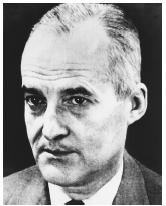Luis Leloir
ARGENTINE CHEMIST
1906–1987
Luis Leloir was born in Paris in 1906. His parents were Argentine, and he resided in Buenos Aires from the age of two and for most of his career until his death in 1987. Leloir received his M.D. from the University of Buenos Aires in 1932, after which he worked at the Institute of Physiology with Professor Bernardo Houssay on the action of adrenalin in carbohydrate metabolism . In 1936 he collaborated with Sir F. G. Hopkins at the Biochemical Laboratory in Cambridge, England. He returned to Buenos Aires to study the oxidation of fatty acids in the liver and on the formation of angiotensin . He was forced to leave Argentina in 1943 when Houssay's laboratory was closed by the government of Juan Perón in response to Houssay's public criticism of the dictatorship. During the next few years Leloir worked in the United States in the laboratory of Carl and Gerty Cori at Washington University in St. Louis, Missouri, and D. E. Green at Columbia University in New York City.
Leloir returned to Argentina in 1945 to take part in the founding of the Instituto de Investigaciones Bioquimicas supported by the Jaime Campomar Foundation. He became the institute's first director. Most of the research at the institute was conducted on a shoestring budget, and some of the complex equipment there was ingeniously built by Leloir or his colleagues R. Caputto, C. E. Cardini, R. Trucco, and A. C. Paladini from everyday objects. For instance, a fraction-collecting device for column chromatography was built with a Meccano set (a toy from Leloir's childhood that was similar to an erector set); its collection bottles moved about with a toy railroad train.

In spite of inadequate funding and the resulting limitations, work began at the new institute on the metabolism of the sugar galactose ; it led to the discovery of glucose 1,6-diphosphate and uridine diphosphate glucose (UDPG). The latter substance was the first sugar nucleotide discovered. Leloir continued his work in this sector of research and discovered several other sugar nucleotides. He and his coworkers determined that UDPG is the nucleotide that provides the glucose units in the biosynthesis of glycogen. Glycogen is the form of polymeric carbohydrate in which energy is stored inside an animal cell, while starch is the form in which energy is stored in plants. Further work demonstrated that the donor of the glucose units for the biosynthesis of starch is adenosine diphosphate glucose (ADPG.) This work was quite important in improving scientists' understanding of the processes by which carbohydrates are converted to energy and the glycogen storage diseases. Leloir received the Nobel Prize in chemistry in 1970; his was the first Nobel Prize in chemistry ever awarded to an Argentine.
Leloir is best remembered for producing Nobel Prize–quality research under very difficult conditions and for contributing significantly to the development of scientific analysis and discovery in Argentina.
SEE ALSO Carbohydrates ; Cori, Carl and Gerty ; Nucleotide .
Lawrence H. Brannigan
Bibliography
Scientific American, ed. (1955). The Physics and Chemistry of Life. (1955). New York: Simon & Schuster.
Internet Resources
The Nobel Foundation. "Nobel e-Museum." Available from http://www.nobel.se .
Southwest Baptist University Web site. Available from http://www.sbuniv.edu .
Comment about this article, ask questions, or add new information about this topic: